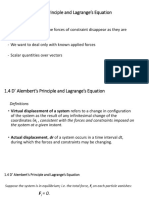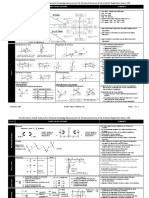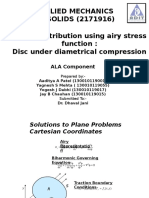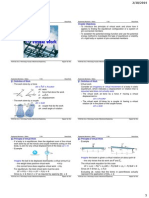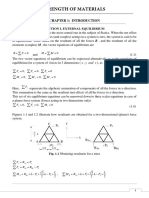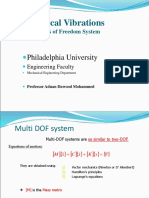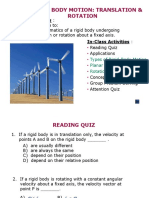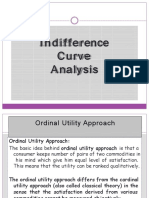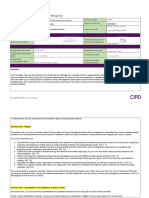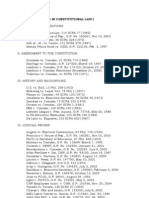Lecture 10 Method of Virtual Work
Uploaded by
Anonymous yorzHjDBdLecture 10 Method of Virtual Work
Uploaded by
Anonymous yorzHjDBdEngineering Mechanics Lecture 10 : Method of Virtual Work
Lecture 10 Method of Virtual Work
So far when dealing with equilibrium of bodies/trusses etcetera, our strategy has been to isolate parts of the system (subsystem) and consider equilibrium of each subsystem under various forces: the forces that we apply on the system and those that the surfaces, and other elements of the system apply on the subsystem. As the system size grows, the number of subsystems and the forces on them becomes very large. The question is can we just focus on the force applied to get it directly rather than going through each and every subsystem. The method of virtual work provides such a scheme. In this lecture, I will give you a basic introduction to this method and solve some examples by applying this method. Let us take an example: You must have seen a children's toy as shown in figure 1. It is made of many identical bars connected with each other as shown in the figure. One of the lowest bars is connected to a fixed pin joint A whereas the other bar is on a pin joint B that can move horizontally. It is seen that if the toy is extended vertically, it collapses under its own weight. The question is what horizontal force F should we apply at its upper end so that the structure does not collapse.
To see how many equations do we have to solve in finding F in the structure above, let us take a simple version of it, made up of only two bars, and ask how much force F do we need to keep it in equilibrium (see figure 2).
Let each bar be of length l and mass m and let the angle between them be . The free-body diagram of the whole system is shown above. Notice that there are four unknowns - NAx , NAy , NBy and F - but only three equilibrium equations: the force equations
and the torque equation
So to solve for the forces we will have to look at individual bars. If we look at individual bars, we also have to take into account the forces that the pin joining them applies on the bars. This introduces two more unknowns N1 and N2 into the problem (see figure 3). However, there are three equations for each bar - or equivalently three equations above and three equations for one of the bars - so that the total number of equations is also six. Thus we can get all the forces on the system.
The free-body diagrams of the two bars are shown in figure 3. To get three more equations, in addition to the three above, we can consider equilibrium of any of the two bars. In the present case, doing this for the bar pinned at B appears to be easy so we will consider that bar. The force equations for this bar
give
And taking torque about B , taking N1 = 0 , gives
This then leads to (from the force equation above)
Substituting these in the three equilibrium equations obtained for the entire system gives
Looking at the answers carefully reveals that all we are doing by applying the force F is to make sure that the bar at pin-joint A is in equilibrium. This bar then keeps the bar at joint B in equilibrium by applying on it a force equal to its weight at its centre of gravity. The question that arises is if we have many of these bars in a folding toy shown in figure 1, how would we calculate F ? This is where the method of virtual work, to be developed in this lecture, would come in handy. We will solve this problem later using the method of virtual work. So let us now describe the method. First we introduce the terminology to be employed in this method. 1. Degrees of freedom: This is the number of parameters required to describe the system. For example a free particle has three degrees of freedom because we require x, y , and z to describe its position. On the other hand if it is restricted to move in a plane, its degrees of freedom an only two. In the mechanism that we considered above, there is only one degree of freedom because angle between the bars is sufficient to describe the system. Degrees of freedom are reduced by the constraints that are put on the possible motion of a system. These are discussed below. 2. Constraints and constraint forces: Constraints and those conditions that we put on the movement of a system so that its motion gets restricted. In other words, a constraint reduces the degrees of freedom of a system. Constraint forces are the forces that are applied on a system to enforce a constraint. Let us understand these concepts through some examples. A particle in free space has three degrees of freedom. However, if we put it on a plane horizontal surface without applying any force in the vertical direction, its motion is restricted to that plane. Thus now it has only two degrees of freedom. So the constraint in this case is that the particle moves on the horizontal surface only. The corresponding force of constraint is the normal reaction provided by the surface.
As the second example, let us take the case of a vertical pendulum oscillating in a plane (see figure 5). Thus its degrees of freedom would be two if there were no more constraints on its motion. However, the bob of a pendulum is constrained to move in such a way that its distance from the pivot point remains fixed. We have thus introduced one more constraint on its motion and therefore the degrees of freedom are reduced by one; a pendulum oscillating in a plane has only one degree of freedom. The angle from the equilibrium position is therefore sufficient to describe a plane pendulum's motion fully. How about the force of constraint in this case? The constraint, that the distance of the bob from the pivot point remains fixed, is ensured by the tension in the string. The tension in the string is therefore the force of constraint.
Let us now consider the folding toy shown in figure 1. This structure, although made of many moving bars, has only one degree of freedom because the bars are constrained to move in a very specific way. Thus from a large number of degrees of freedom for these bars, all of them except one are eliminated by the constraints. As such the number of constraints, and therefore the number of constraint forces, is very large. The constraint forces are the reactions at the supports A and B and the forces applied by the pins holding the bars together. It is because of these forces that the system is restricted in its motion. I would like you to note one thing interesting in the examples considered above: if the system moves the
constraint forces do not do any work on it. In the case of a particle moving on a plane, the motion is perpendicular to the normal reaction so it does no work on the particle. In the pendulum the motion of the bob is also perpendicular to the tension in the string which is the force of constraint. Thus no work is done on the bob by the constraint force. The case of the toy in figure 1 is quite interesting. In the structure point A does not move and the motion of point B is perpendicular to the reaction force at B. Thus there is no work done by the reaction forces at these points. On the other hand, the constraint forces due to pins connecting two bars are equal and opposite on each bar. But the points on the bar where these forces act (the points where the pin joints are) have the same displacement for each bar so that the net work done by the constraint forces vanishes. 3. Virtual displacement: Given a system in equilibrium, its virtual displacement is imagined as follows: Move the system slightly away from its equilibrium position arbitrarily but consistent with the constraints. This represents a virtual displacement of the system. Note the emphasis on the word imagined. This is because a virtual displacement is not caused by the applied forces. Rather it is the difference between the equilibrium position of the system and an imagined position - consistent with the constraints - of the system slightly away from the equilibrium. For example in the case of a pendulum under equilibrium at an angle under a force P (see figure 6), virtual displacement would be increasing the angle from to ( + ) keeping the distance of the bob from the pivot unchanged. On the other hand, moving the bob with a component in the direction of the string is not a virtual displacement because it will not be consistent with the constraint. Virtual displacement is denoted by real displacement . to distinguish it from a
4. Virtual work: The work done by any force denoted by . Thus
during a virtual displacement is called virtual work. It is
Note that our previous observation, that work done by a constraint force is usually zero, implies that virtual work done by a constraint force is also zero. Also keep in mind that in calculating the work done by the force being applied. , represents the displacement of the point where the force is
With these definitions we are now ready to state the principle of virtual work. It is based on the assumption that virtual work done by a constraint force is zero. The principle of virtual work states that
" The necessary and sufficient condition for equilibrium of a mechanical system without friction is that the virtual work done by the externally applied forces is zero ". Let us see how it arises. For a system in equilibrium, each particle in the system is in equilibrium under the influence of externally applied forces th and the forces of constraints. Then for the i particle
Therefore
But we have already seen that for individual particles
and for a system
composed of many subsystems , that is the net virtual work done by constraint forces is zero. This means that the total virtual work done by the external forces vanishes, i.e.
This is the necessary part of the proof. The condition is also sufficient condition. This is proved by showing that if the body is not in equilibrium, the virtual work done by the external forces does not vanish for all arbitrary virtual displacements (consistent with the constraints). If the body is not in equilibrium, it will move in the direction of the net force on each particle. During this real displacement the work don by the force on the i particle will be positive i.e.
th
Now we can choose this real displacement to be the virtual displacement and find that when the body is not in equilibrium, all virtual displacements consistent with the constraints will not give zero virtual work. Thus when the system is not in equilibrium
Assuming again that the net work done by the constraint forces is zero, we get that for a body not in equilibrium
This implies that when the virtual work done by external forces vanishes, the system must be in equilibrium. This proves the sufficiency part of the condition. We now solve some examples to illustrate how the method of virtual work is applied.
Engineering Mechanics Lecture 10 : Method of Virtual Work
Example 1: A pendulum in equilibrium as shown in figure 5. We show the coordinates of the bob in the
figure 7 below.
If the pendulum is give a virtual displacement i.e.
By the principle of virtual work, the total virtual work done by the external forces vanishes at equilibrium. So the equilibrium is described by
giving
Which is the same answer as obtained earlier.
Example 2: This is the problem involving two crossed bars as shown in figure 2. We wish to calculate the force F required to keep the system in equilibrium using the principle of virtual work. To apply the principle of virtual work, imagine a virtual displacement consistent with the constraint. The only displacement possible - because of only one degree of freedom - is that 2 it is clear that the external forces on the system are F and 2mg (weight of the bars). . From figure
As increased to + , the point where the bars cross moves down by a distance (see figure 8)
and the point when F is applied moves to the right by a distance
To calculate the net virtual work done, I remind you that work by a force
is calculated by taking the
dot product , where represents the displacement of the point where the force is being applied. Thus the virtual work in the present case is
For equilibrium we equate this to zero to get
which is the same result as obtained earlier. So you see in both these examples that by applying the method of virtual work, we have bypassed calculating the constraint forces completely and that is what makes the method easy to implement in large systems. The way to learn the method well is to practice as many problems as possible. I will now solve some examples to demonstrate the usefulness of the method for large system. To start with let us take the example which we gave in the beginning - that of toy with made with bars. Example 3: If there are N crossings in the folding toy shown in figure 9, what is the force required to keep the system in equilibrium?
Again the degree of freedom = 1. The variable we use to describe the position of the mechanism is the angle between the bars i.e. . As the angle is changed to (+ ), the upper end of the bar where force F is applied moves in the direction opposite to the force by
Thus the virtual work done by F is
On the other hand, the first crossing moves down by
The second crossing by
and the Nth crossing moves down by
All these displacements are in the same direction as the force = 2mg at each of the bar crossings. Thus the virtual work done by the weight of the mechanism is
This gives a total virtual work done by the external forces to be
Equating this to zero for equilibrium gives
For N = 1 the answer matches with that obtained in the case of only two bars in example 2 above. For 2 larger N , the force required to keep equilibrium goes up by a factor of N .
Example 4: A 6m long electric pole of weight W starts falling to one side during rains. It is kept from falling by tying a strong rope at its centre of gravity (assumed to be right in the middle of the pole) and securing the other end of the rope on ground. All the relevant distances are given in figure 10. Assume that the lower end of the pole is like a pin joint. Under these conditions we want to find the tension in the rope using the method of virtual work.
In this problem also there is only one degree of freedom . The constraint is that the pole can only rotate about the assumed pin joint at the ground. The constraint forces are the reactions at the ground and do no work on the pole when it rotates. There is also the constraint of the rigidity of the pole. Extend forces are W and T. By principle of virtual work when is changed to ( + ) , the total virtual work vanishes. If the centre of gravity moves up by y and to the left by x as is increased to ( + ) , the virtual work done is
which, when equated to zero, gives
From the figure it is easy to see that
and (only the magnitude)
Substituting these in the expression for the tension gives
This concludes the lecture on the method of virtual work. In the lecture, I have given you an introduction to the method assuming that constraints do no work. The method is really useful when there are many constraints and the system is complicated. It makes calculations easier by avoiding calculating constraint forces. The method also provides basis for simplifying dynamics calculations under constrained motion. You will be learning more about it in an advanced course.
You might also like
- Chapter 4 Equilibrium PF Rigid Body & ForceNo ratings yetChapter 4 Equilibrium PF Rigid Body & Force61 pages
- Chapter Six: Analysis of Analysis of Structures100% (1)Chapter Six: Analysis of Analysis of Structures33 pages
- Chapter 18: Planar Kinetics of A Rigid Body: Work and EnergyNo ratings yetChapter 18: Planar Kinetics of A Rigid Body: Work and Energy11 pages
- LEC. (1) - Kinematics of Rigid Bodies-Definitions-Translation-Rotational Motion-ExamplesNo ratings yetLEC. (1) - Kinematics of Rigid Bodies-Definitions-Translation-Rotational Motion-Examples7 pages
- Principle of Virtual Work and D'Alembert's PrincipleNo ratings yetPrinciple of Virtual Work and D'Alembert's Principle10 pages
- Strength of Materials - Simple Stresses - Hani Aziz Ameen100% (1)Strength of Materials - Simple Stresses - Hani Aziz Ameen23 pages
- Theory: Forced Vibration of Two Degrees of Freedom SystemNo ratings yetTheory: Forced Vibration of Two Degrees of Freedom System4 pages
- Planar Kinematics of A Rigid Body: Ir. Dr. Mohd Noor Arib Bin MD RejabNo ratings yetPlanar Kinematics of A Rigid Body: Ir. Dr. Mohd Noor Arib Bin MD Rejab23 pages
- Equilibrium of Particle FBD of 2-D Systems: ObjectivesNo ratings yetEquilibrium of Particle FBD of 2-D Systems: Objectives20 pages
- CH 4 - The Vibrations of Systems Having TDOFNo ratings yetCH 4 - The Vibrations of Systems Having TDOF17 pages
- Engineering Mechanics-Statics of ParticlesNo ratings yetEngineering Mechanics-Statics of Particles97 pages
- Equillibrium of Non Concurrent Coplanar SystemNo ratings yetEquillibrium of Non Concurrent Coplanar System17 pages
- 16 1 Translation and Rotation of Rigid Body PDFNo ratings yet16 1 Translation and Rotation of Rigid Body PDF24 pages
- Tutoring Solid Mechanics Matteo PedranzNo ratings yetTutoring Solid Mechanics Matteo Pedranz124 pages
- Chapter - 1 - Static Force Analysis PDFNo ratings yetChapter - 1 - Static Force Analysis PDF29 pages
- Self Assessment Report Sar For Accredita PDFNo ratings yetSelf Assessment Report Sar For Accredita PDF314 pages
- Onward Journey Ticket Details E Ticket Advance ReservationNo ratings yetOnward Journey Ticket Details E Ticket Advance Reservation1 page
- Unit-4: Fuels & Combustion: Mr. Santosh Damkondwar Friday, January 02, 2015No ratings yetUnit-4: Fuels & Combustion: Mr. Santosh Damkondwar Friday, January 02, 201515 pages
- Jawaharlal Nehru Technological University Hyderabad: I Year B.Tech. (R13)No ratings yetJawaharlal Nehru Technological University Hyderabad: I Year B.Tech. (R13)1 page
- IV YrMech I Sem Time Table - 30!6!2014 FINALNo ratings yetIV YrMech I Sem Time Table - 30!6!2014 FINAL1 page
- Tuesday, October 28, 2014 8:15 AM: Unfiled Notes Page 1No ratings yetTuesday, October 28, 2014 8:15 AM: Unfiled Notes Page 12 pages
- Product Recommendation Eaton Fuller Heavy-Duty Transmissions 13 - 18 Speed RT-6613No ratings yetProduct Recommendation Eaton Fuller Heavy-Duty Transmissions 13 - 18 Speed RT-66132 pages
- Accelerate Philly, Strategic Plan Executive SummaryNo ratings yetAccelerate Philly, Strategic Plan Executive Summary12 pages
- U.S. E T, A RFQ PR9037551: Mbassy Irana LbaniaNo ratings yetU.S. E T, A RFQ PR9037551: Mbassy Irana Lbania49 pages
- 5CO02 - 20s-Khalid Qasem - AR1 Report - V2No ratings yet5CO02 - 20s-Khalid Qasem - AR1 Report - V29 pages
- Going Aloft / Working Over Side Permit: GeneralNo ratings yetGoing Aloft / Working Over Side Permit: General2 pages
- Fake Account Detection Using Machine Learning Techniques100% (1)Fake Account Detection Using Machine Learning Techniques7 pages
- Pretest Letter To Parents For ScholasticNo ratings yetPretest Letter To Parents For Scholastic2 pages
- Bharti Airtel Limited Performance AppraisalNo ratings yetBharti Airtel Limited Performance Appraisal13 pages
- Chapter 18: Planar Kinetics of A Rigid Body: Work and EnergyChapter 18: Planar Kinetics of A Rigid Body: Work and Energy
- LEC. (1) - Kinematics of Rigid Bodies-Definitions-Translation-Rotational Motion-ExamplesLEC. (1) - Kinematics of Rigid Bodies-Definitions-Translation-Rotational Motion-Examples
- Principle of Virtual Work and D'Alembert's PrinciplePrinciple of Virtual Work and D'Alembert's Principle
- Strength of Materials - Simple Stresses - Hani Aziz AmeenStrength of Materials - Simple Stresses - Hani Aziz Ameen
- Theory: Forced Vibration of Two Degrees of Freedom SystemTheory: Forced Vibration of Two Degrees of Freedom System
- Planar Kinematics of A Rigid Body: Ir. Dr. Mohd Noor Arib Bin MD RejabPlanar Kinematics of A Rigid Body: Ir. Dr. Mohd Noor Arib Bin MD Rejab
- Equilibrium of Particle FBD of 2-D Systems: ObjectivesEquilibrium of Particle FBD of 2-D Systems: Objectives
- Onward Journey Ticket Details E Ticket Advance ReservationOnward Journey Ticket Details E Ticket Advance Reservation
- Unit-4: Fuels & Combustion: Mr. Santosh Damkondwar Friday, January 02, 2015Unit-4: Fuels & Combustion: Mr. Santosh Damkondwar Friday, January 02, 2015
- Jawaharlal Nehru Technological University Hyderabad: I Year B.Tech. (R13)Jawaharlal Nehru Technological University Hyderabad: I Year B.Tech. (R13)
- Tuesday, October 28, 2014 8:15 AM: Unfiled Notes Page 1Tuesday, October 28, 2014 8:15 AM: Unfiled Notes Page 1
- Product Recommendation Eaton Fuller Heavy-Duty Transmissions 13 - 18 Speed RT-6613Product Recommendation Eaton Fuller Heavy-Duty Transmissions 13 - 18 Speed RT-6613
- Accelerate Philly, Strategic Plan Executive SummaryAccelerate Philly, Strategic Plan Executive Summary
- Fake Account Detection Using Machine Learning TechniquesFake Account Detection Using Machine Learning Techniques























